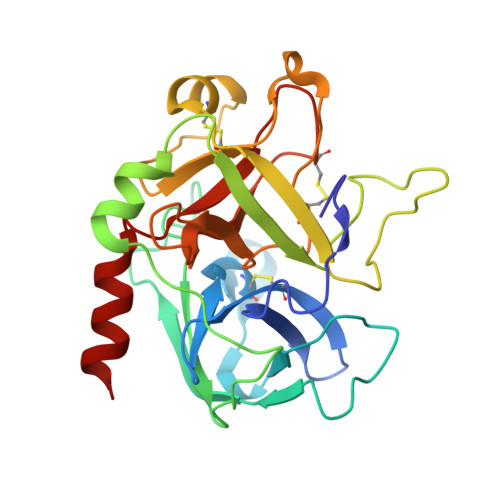Gpibalpha Interacts Exclusively with Exosite II of Thrombin
Lechtenberg, B.C., Freund, S.M.V., Huntington, J.A.(2014) J Mol Biol 426: 881
- PubMed: 24316004
- DOI: https://doi.org/10.1016/j.jmb.2013.11.027
- Primary Citation of Related Structures:
4CH2, 4CH8 - PubMed Abstract:
Activation of platelets by the serine protease thrombin is a critical event in haemostasis. This process involves the binding of thrombin to glycoprotein Ibα (GpIbα) and cleavage of protease-activated receptors (PARs). The N-terminal extracellular domain of GpIbα contains an acidic peptide stretch that has been identified as the main thrombin binding site, and both anion binding exosites of thrombin have been implicated in GpIbα binding, but it remains unclear how they are involved. This issue is of critical importance for the mechanism of platelet activation by thrombin. If both exosites bind to GpIbα, thrombin could potentially act as a platelet adhesion molecule or receptor dimerisation trigger. Alternatively, if only a single site is involved, GpIbα may serve as a cofactor for PAR-1 activation by thrombin. To determine the involvement of thrombin's two exosites in GpIbα binding, we employed the complementary methods of mutational analysis, binding studies, X-ray crystallography and NMR spectroscopy. Our results indicate that the peptide corresponding to the C-terminal portion of GpIbα and the entire extracellular domain bind exclusively to thrombin's exosite II. The interaction of thrombin with GpIbα thus serves to recruit thrombin activity to the platelet surface while leaving exosite I free for PAR-1 recognition.
Organizational Affiliation:
Department of Haematology, Cambridge Institute for Medical Research, University of Cambridge, Wellcome Trust/MRC Building, Hills Road, Cambridge CB2 0XY, United Kingdom.




















